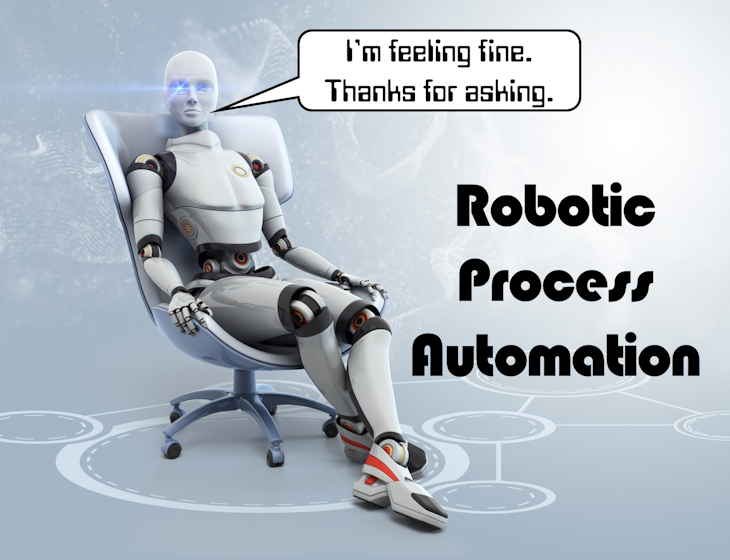As the global Covid-19 outbreak spread, many businesses ground to a halt as workers were ordered to stay (or work from) home in an effort to halt the virus’ spread. The impact on company bottom lines, as well as national and global economies, has been devastating. Although I haven’t seen any data, my gut tells me companies leveraging automated processes are faring better than those that aren’t. The logic is simple: Bots and robots don’t get sick and don’t require social distancing. Amdoc’s Pamella Admoni Sawday writes, “With working from home becoming the de facto norm for so many employees, service providers are facing significant challenges in their ability to maintain business-as-usual service levels. … So how do you optimize your operations — and their associated changes in workflows and frameworks — to ensure business continuity during these times of uncertainty? Let the robots take care of business. This is where Robotic Process Automation (RPA) comes in. Essentially, the technology enables repetitive, rule-based tasks to be shifted from people to robots. By doing this, the burden on communication infrastructures and productivity business systems is greatly reduced. Furthermore, error rates are greatly decreased, customer service levels are not compromised and business-as-usual operational efficiency is maintained.”[1] For anyone unfamiliar with the term robotic process automation, Sawday’s description of robots doing tedious, repetitive tasks conjures up images of metallic, physical machines working away in a physical space. As explained below, RPA actually uses software robots (aka bots) rather than hardware robots.
That doesn’t mean physical robots haven’t played a role during the Covid-19 crisis. Futurist Bernard Marr (@bernardmarr) reports, “Medtech companies are rolling out robots and drones to help fight it and provide services and care to those quarantined or practicing social distancing. This pandemic has fast-tracked the ‘testing’ of robots and drones in public as officials seek out the most expedient and safe way to grapple with the outbreak and limit contamination and spread of the virus.”[2] He adds, “COVID-19 is taxing healthcare systems and medical professionals in every country it spreads to. Telemedicine, supported by robots, makes it possible for medical professionals to communicate with patients remotely, saving time and allowing possibly contagious patients to stay confined.” Marr goes on to describe how robots working in logistics areas, like warehouses and last-mile delivery, are also playing a role. He concludes, “In an outbreak, the scale of coronavirus (COVID-19) robots and drones could become an increasingly essential support for humans in fighting the virus.”
What is robotic process automation?
Kevin Casey (@kevinrcasey) writes, “The phrase itself might sound complicated or scary, but the possible benefits of RPA are pretty simple: Use software to automatically handle repetitive (and often boring) computer-based tasks that previously hogged a person’s time. Moreover, the processes that make good fits for RPA usually take up human hours with work that requires minimal (or no) skill or creativity. It’s ultimately about efficiency.”[3] He goes on to explain, “The ‘robot’ in robotic process automation is software running on a physical or virtual machine.” Aaron Bultman, director of product at Nintex, told Casey, “RPA is a form of business process automation that allows anyone to define a set of instructions for a robot or ‘bot’ to perform. RPA bots are capable of mimicking most human-computer interactions to carry out a ton of error-free tasks, at high volume and speed.” Or as Casey states, “Think copy-paste tasks and moving files from one location to another.”
With people concerned about returning to jobs they lost during the pandemic, talk about robotic process automation taking over work can be concerning. For the most part, however, RPA assumes tasks rather than entire jobs. As Casey explains in a more recent article, “Robotic Process Automation should be a positive — a chance to reduce drudge work. But when some people hear RPA, they think job loss.”[4] He suggests five things employers can do to relieve employees of RPA angst. They are:
1. Make sure people understand what RPA is. Casey writes, “You can’t skip this step, or you’re allowing misconceptions to fester.” More often than not, employees will be happy to be relieved of tedious tasks.
2. Bring people into the RPA process early. “Don’t build an RPA program first and explain it to people later,” Casey explains. “Bring employees and stakeholders into the process early and often. … You need to be able to explain the specific use cases and goals for your RPA program.”
3. Be specific about RPA’s upside. According to Casey, “It’s one thing to tell people — insist, even — that RPA will improve their jobs. It’s far more powerful to show them how, or to at least light the paths to new or expanding opportunities that will result from automating some of the monotonous tasks that currently eat up chunks of their time.”
4. Record the journey and create RPA evangelists. Casey writes, “Long-term RPA success depends not just on calming anxieties but proactively winning [employees] over.” Being able to demonstrate before and after working conditions can make employees RPA evangelists.
5. Name your bots (Really). Casey observes, “Working alongside a bunch of ‘bots’ might sound a little ominous to some people. But they’ll seem less so if they have names like, say, ‘Fred’.” Even makers of physical robots understand a bit of anthropomorphizing can make robots seem less menacing. Casey concludes, “Let your team humanize your digital workers by giving them names and other real-world characteristics. Better still, let people on your team do the naming.”
Beyond robotic process automation
RPA is one of the fastest growing technologies and is often called a gateway to artificial intelligence (AI). In fact, some experts believe the combination of AI and RPA is the next evolution in office automation. Thomas H. Davenport (@tdav), a distinguished professor at Babson College, asserts, “When paired with robotic process automation, AI significantly expands the number and types of tasks that software robots can perform.”[5] Davenport cautions, however, “Software robots that use AI could displace more jobs, especially if we head into a recession. Companies will use it for substantial headcount and cost reductions.” More likely, however, is that AI-enhanced RPA will still assume tasks rather than jobs. I call the next step Cognitive Process Automation™ (CPA).
Greg Council, Vice President of Marketing and Product Management at Parascript, explains, “RPA software lacks built-in ‘intelligence’. Most ‘bots’ — a term that identifies a specific automation routine — only work against given rule sets in structured processes. They don’t adapt to new scenarios or learn from mistakes. This realm of AI is called ‘machine learning.’ The most mature (but still relatively new) RPA application of machine learning is the advance of ‘learn by example’ into the bot-configuration process, where a system can monitor — completely in the background — a given SME’s actions for different situations. This monitoring manifests itself as a ‘learned’ set of rules that can be implemented once complete, and it can be superior and more flexible than traditional rule-based approaches.”[6] Not every business process requires Cognitive Process Automation; however, when a process needs to respond to changing conditions, CPA may prove extremely beneficial.
Concluding thoughts
In times of crisis, conducting as much business-as-usual as possible becomes important if not critical. Having automated processes in place facilitating business-as-usual could spell the difference between making it through a crisis or having to shutter your operation. Even laid-off employees find some comfort in knowing they will have a job to come back to.
Footnotes
[1] Pamella Admoni Sawday, “How Robotic Process Automation Helps Ensure Business Continuity in the Age of Covid-19,” Amdocs, 18 March 2020.
[2] Bernard Marr, “Robots And Drones Are Now Used To Fight COVID-19,” Forbes, 18 March 2020.
[3] Kevin Casey, “Robotic process automation (RPA): How it works,” The Enterprisers Project, 17 October 2019.
[4] Kevin Casey, “How to tame Robotic Process Automation (RPA) anxiety,” The Enterprisers Project, 16 March 2020.
[5] Smriti Srivastava, “How AI + Automation can Transform Tedious Office Tasks,” Analytics Insight, 16 March 2020.
[6] Greg Council, “Injecting (Artificial) Intelligence into Robotic Process Automation,” Experfy, 2 May 2018.





